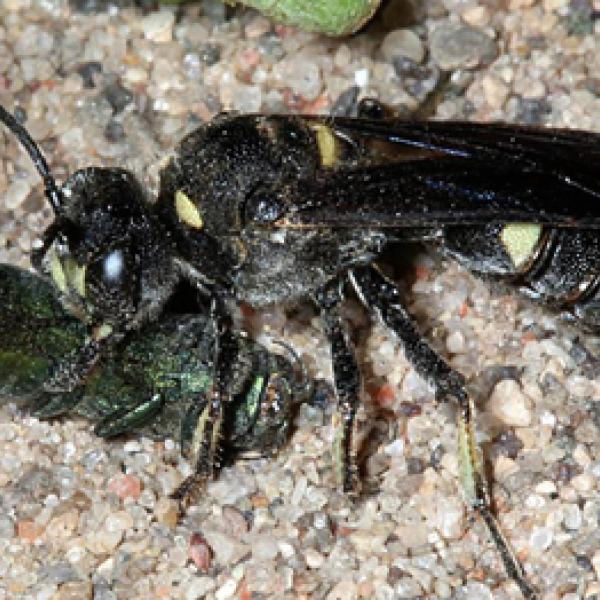
News Source
The emerald ash borer (Agrilus planipennis) is a pest species that has killed tens of millions of ash trees and has the potential to kill most of the 8.7 billion ash trees in North America. The beetle, native to Asia, was accidentally introduced to the U.S. in 2002 in Michigan. Since then, it has spread into the eastern U.S. and southeastern Canada.
Early warning of EAB infestation is critical to treatment and survival of the several species of ash tree affected. But censusing methods have been expensive and difficult. Therefore, scientists have learned to utilize the services of a native ground wasp, Cerceris fumipennis, to estimate the abundance of EAB in a particular area.
C. fumipennis is a solitary hunting wasp that preys almost exclusively on wood-boring buprestid beetles. The adult wasp catches and paralyzes a beetle with its stinger, carries it back to its nest, then drags the beetle inside and lays an egg on it. The egg then hatches and the larva eats the beetle.
C. fumipennis is valuable in detecting EAB because the wasps bring the beetles to their nests, and surveyors can catch returning wasps with their prey in order to see whether the EAB is in the area.
A female wasp may have several paralyzed beetles in her nest. The nest is underground, visible above ground as a pencil-sized hole with a pile of excavated soil around it. Several nests — from five to 500 — may be loosely aggregated into a large, loose colony. The wasps make their nests in well-packed sandy soil in sunny areas, often on campsites, dirt roads, playgrounds, baseball diamonds, and near forests, where they search for prey.
The WaspWatchers
Philip Careless at the University of Guelph, Ontario, Canada, began this biosurveillance program as his master’s degree project. It was taken up in 2008 by U.S. forest health managers for detecting EAB infestations early. Colleen Teerling, a forest entomologist with the Maine Department of Agriculture, Conservation and Forestry, was instrumental in setting up the C. fumipennis volunteer program — also known as WaspWatchers — in the United States.
In Maine, news of the project spread by word of mouth at first. Later, said Teerling, “I’d call up a town office and talk with the counselor and town manager and explain what we were doing, what we were looking for, and sometimes they would have an idea of who might be interested. I had a couple of town selectmen be volunteers for wasp colonies in their towns.” She also found volunteers in the Master Gardeners Program in Maine. Soon, the WaspWatchers biosurveillance method was adopted by other states.
This is where you come in. You can be a WaspWatcher by helping scientists conduct biosurveillance in the field, doing exactly what they do with the same equipment. You’ll be trained to catch wasps, snag the beetles, and record the findings.
The WaspWatchers punch holes in paper and place it over the wasp’s nest. When the female wasp returns, she can’t bring her prey with her through the hole, and the beetles are collected by the citizen scientists.
Most WaspWatcher states also have an “adopt-a-colony” program, where scientists turn over wasp colonies to volunteers who monitor them. Typically, the scientists survey the state when the wasps emerge for the spring or summer, marking down the locations of wasp colonies. Satellite imagery is used to locate baseball diamonds, which are easily recognizable. The colonies are then the responsibility of the WaspWatchers.
The collected beetles are placed in baggies, and at the end of the summer they are sent by mail to the scientists, who then examine and identify the species. C. fumipennis doesn’t sting humans, even when handled, so there’s no chance of the surveyor going home with a sore hand.
This method of biosurveillance gives researchers an early warning about EAB infestations, vital for allowing time to quarantine forest tracts and treat affected trees. But it also gives citizen scientists a chance to make new discoveries, because the wasps bring other beetles back to their nests besides EAB. For instance, C. fumipennis wasps collected 29 specimens of Buprestis consularis from three North Carolina counties where they had never been seen before.
“WaspWatchers are responsible for collecting multiple new state records over a four-year period in North Carolina, including the first state record of the bronze birch borer (Agrilus anxius) in North Carolina,” said Whitney Swink, a plant pest specialist with the North Carolina Department of Agriculture and Consumer services.
Exactly when the wasps emerge and begin a season of hunting beetles and how long they are active varies according to latitude, northerly ones emerging later. In Ontario, the wasps emerge in late June and are active until early September. In North Carolina, they are active from late May and early June through the end of June and early July.
That means there’s time for you to get involved. Click here for a list of WaspWatcher contacts. If you don’t see any near you, do an Internet search with the term WaspWatchers and your state and you’re sure to find one, if it exists.
Happy hunting!